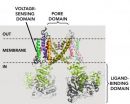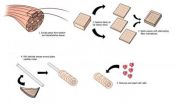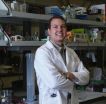(Press-News.org) Two studies in The Journal of General Physiology (JGP) help pave the way for a "shortcut" model-free approach to studying activation of "polymodal" ion channels—channels that open in response to multiple stimuli. Transmembrane ion channels respond to various physiological stimuli to regulate numerous cellular functions. Different classes of channels respond to different types of stimuli; some channels, for instance, respond to changes in membrane potential whereas others are activated by ligand binding. Polymodal channels integrate different cellular signals, enabling them to mediate a more precise and flexible physiological response. Understanding the mechanisms involved in polymodal channel activation has been a challenge, however, in part because of the complexity of the models required.
Now, two studies in the January issue of JGP use straightforward thermodynamically rigorous analysis to parse the free energy of polymodal voltage- and ligand-dependent ion channels. In one study, University of Wisconsin–Madison researchers Sandipan Chowdhury and Baron Chanda examine the BK channel—a channel activated by both changes in membrane potential and calcium binding to an intracellular domain. In the second study, Daniel Sigg (dPET Professional Services) explores gating of polymodal ion channels in general. Specifically, the authors show how to use G-V (conductance-voltage), Q-V (charge-voltage) and conductance vs. ligand concentration measurements to extract the free energies of interaction of the modules of a polymodal channel that respond to these distinct modalities
This new approach opens the door for a model-independent way to studying ion channel gating, which could be useful both for constraining future atomic-scale models of channel gating, and in understanding the disruptions that result from disease causing genetic mutations.
INFORMATION:
About The Journal of General Physiology
Founded in 1918, The Journal of General Physiology (JGP) is published by The Rockefeller University Press. All editorial decisions on manuscripts submitted are made by active scientists. JGP content is posted to PubMed Central, where it is available to the public for free six months after publication. Authors retain copyright of their published works and third parties may reuse the content for non-commercial purposes under a creative commons license. For more information, please visit www.jgp.org.
Chowdhury, S., and B. Chanda. 2013. J. Gen. Physiol. doi:10.1085/jgp.201210860
Sigg, D., et al. 2013. J. Gen. Physiol. doi:10.1085/jgp.201210859
Yifrach, O. 2013. J. Gen. Physiol. doi:10.1085/jgp.201210929
A model-free way to characterize polymodal ion channel gating
2012-12-28
ELSE PRESS RELEASES FROM THIS DATE:
Slice, stack, and roll: A new way to build collagen scaffolds
2012-12-28
MEDFORD/SOMERVILLE, Mass. (December, 26 2012) – Tufts University School of Engineering researchers have developed a novel method for fabricating collagen structures that maintains the collagen's natural strength and fiber structure, making it useful for a number of biomedical applications.
Collagen, the most abundant protein in the body, is widely used to build scaffolds for tissue engineering because it is biocompatible and biodegradable. Collagen is, however, hard to work with in its natural form because it is largely insoluble in water, and common processing techniques ...
GSA Bulletin celebrates GSA's 125th Anniversary with new geologic time scale
2012-12-28
Boulder, Colo., USA – GSA BULLETIN articles posted online between 10 Dec. and 21 Dec. 2012 include a new version of The Geological Society of America's Geologic Time Scale. This paper marks the beginning of a special series of invited papers in celebration of GSA's 125th Anniversary in 2013. Highlights are provided below.
1. A new/revised GSA geologic time scale.
2. Complex mammal fossil record of the Gran Barranca, Patagonia, Argentina.
3. A new and simple method for estimating the rate of sediment delivery to ancient basins.
4. A study of the provenance of volcanic ...
Monkey see, monkey do: Visual feedback is necessary for imitating facial expressions
2012-12-28
Research using new technology shows that our ability to imitate facial expressions depends on learning that occurs through visual feedback.
Studies of the chameleon effect confirm what salespeople, tricksters, and Lotharios have long known: Imitating another person's postures and expressions is an important social lubricant.
But how do we learn to imitate with any accuracy when we can't see our own facial expressions and we can't feel the facial expressions of others?
Richard Cook of City University London, Alan Johnston of University College London, and Cecilia Heyes ...
Strange behavior: New study exposes living cells to synthetic protein
2012-12-28
One approach to understanding components in living organisms is to attempt to create them artificially, using principles of chemistry, engineering and genetics. A suite of powerful techniques—collectively referred to as synthetic biology—have been used to produce self-replicating molecules, artificial pathways in living systems and organisms bearing synthetic genomes.
In a new twist, John Chaput, a researcher at Arizona State University's Biodesign Institute and colleagues at the Department of Pharmacology, Midwestern University, Glendale, AZ have fabricated an artificial ...
Penn team developing new class of malaria drugs using essential calcium enzyme
2012-12-28
PHILADELPHIA - Calpain, a calcium-regulated enzyme, is essential to a host of cellular processes, but can cause severe problems in its overactivated state. It has been implicated as a factor in muscular dystrophy, AIDS, Alzheimer's disease, multiple sclerosis, and cancer. As such, finding and exploiting calpain inhibitors is an important area of research.
A team from the Perelman School of Medicine, University of Pennsylvania, in collaboration with the University of California at San Francisco and the Department of Biochemistry and Protein Function Discovery at Queen's ...
Vanderbilt study examines Affordable Care Act's impact on uncompensated care
2012-12-28
Nashville (Tenn.) - The decision by several states not to expand Medicaid health insurance for the poor may create unintended cuts for hospitals that provide uncompensated care, according to a study by John Graves, Ph.D., a Vanderbilt policy expert in the Department of Preventive Medicine.
Graves used financial data from U.S. hospitals and insurance data in each state to predict cuts in Medicare and Medicaid disproportionate share (DSH) funds paid to the nearly three-fourths of U.S. hospitals that serve low-income patients. The results, published in the Dec. 20 issue ...
Penn team mimicking a natural defense against malaria to develop new treatments
2012-12-28
PHILADELPHIA - One of the world's most devastating diseases is malaria, responsible for at least a million deaths annually, despite global efforts to combat it. Researchers from the Perelman School of Medicine at the University of Pennsylvania, working with collaborators from Drexel University, The Children's Hospital of Philadelphia, and Johns Hopkins University, have identified a protein in human blood platelets that points to a powerful new weapon against the disease. Their work was published in this months' issue of Cell Host and Microbe.
Malaria is caused by parasitic ...
2 new species of orchid found in Cuba
2012-12-28
Researchers from the University of Vigo, in collaboration with the Environmental Services Unit at the Alejandro de Humboldt National Park (Cuba), have discovered two new species of Caribbean orchid.
The Caribbean islands have been natural laboratories and a source of inspiration for biologists for over two centuries now. Suffice to say that the studies by Charles Darwin and Alfred Russel Wallace in the tropical archipelagos contributed to the emergence of the theory of evolution.
In this case, a Spanish research team from the University of Vigo has discovered two new ...
Broader background checks and denial criteria could help prevent mass shooting catastrophes
2012-12-28
UC Davis Health System is improving lives and transforming health care by providing excellent patient care, conducting groundbreaking research, fostering innovative, interprofessional education, and creating dynamic, productive partnerships with the community. The academic health system includes one of the country's best medical schools, a 619-bed acute-care teaching hospital, a 1000-member physician's practice group and the new Betty Irene Moore School of Nursing. It is home to a National Cancer Institute-designated comprehensive cancer center, an international neurodevelopmental ...
Trying to halt hepatitis C's molecular hijacking
2012-12-28
AURORA, Colo. (Dec. 27, 2012) – Researchers at the University of Colorado School of Medicine have figured out intimate details of how the hepatitis C virus takes over an invaded cell, a breakthrough that could point to way for new treatments for the virus.
Hep C hijacks the machinery by which a cell makes proteins and uses it instead to create proteins for the virus. Over the last two decades, researchers have figured out that Hep C uses an RNA molecule to do this. Now they're trying to fill in the details.
One key detail is reported in a paper published online Dec. ...





